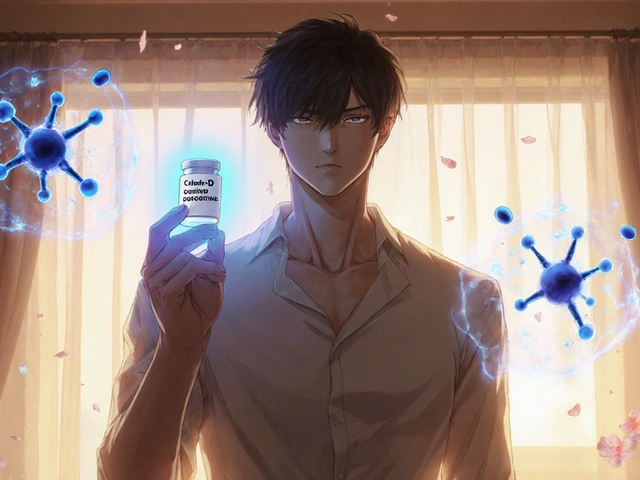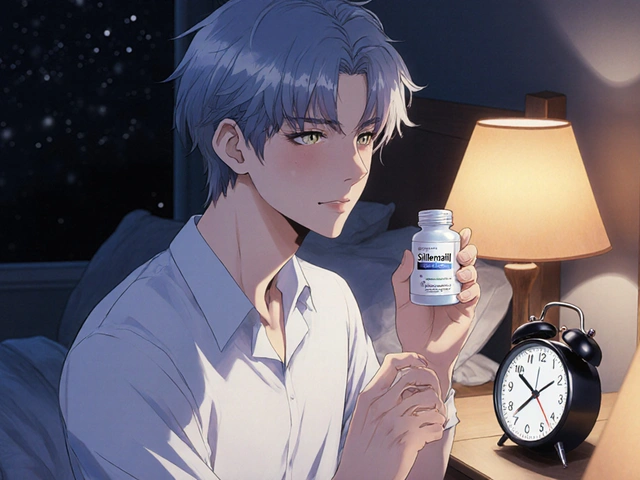Sildenafil Sleep Impact Calculator
How Sildenafil timing affects your sleep quality. Input your dosage and bedtime timing to see the potential impact on your rest.
When you pop a pill to help with erectile dysfunction, the last thing on your mind is usually how it will mess with your night’s shut‑eye. Yet a surprising number of men notice changes in how fast they fall asleep, how deep their sleep feels, or even how often they wake up. Below we break down what sildenafil does inside your body, why those actions can ripple into your bedtime routine, and what practical steps you can take to keep both performance and rest on point.
Key Takeaways
- Sildenafil peaks in the bloodstream 1‑2 hours after ingestion, a window that often overlaps with the start of your sleep cycle.
- The drug’s vasodilating effect can lower blood pressure briefly, which may make you feel light‑headed or cause nighttime awakenings.
- Common side effects such as headaches, flushing, and nasal congestion can interfere with falling asleep.
- Timing your dose at least 2‑3 hours before bed and pairing it with a relaxed environment usually minimizes sleep disruption.
- If you have sleep‑related conditions (e.g., sleep apnea) or use alcohol, discuss dosage adjustments with your doctor.
Sildenafil is a phosphodiesterase type 5 (PDE5) inhibitor originally developed to treat heart‑related chest pain but now best known for treating erectile dysfunction (ED). By relaxing smooth muscle in the penile arteries, it boosts blood flow when sexual stimulation occurs. Sleep is a complex, biologically‑regulated state that cycles through light (NREM) and deep (REM) phases, each serving distinct restorative functions. Understanding how these two processes intersect helps you avoid unintended nighttime grogginess.
How Sildenafil Works - The Science in Plain English
When you swallow sildenafil, it quickly enters your bloodstream and starts inhibiting the enzyme PDE5. This inhibition leads to an increase in cyclic guanosine monophosphate (cGMP), a molecule that relaxes blood vessels. The result? Faster and fuller erections during sexual activity. But the same vasodilating action isn’t limited to the penis - it can affect vessels throughout the body, including those in the brain and lungs.
Three pharmacokinetic milestones matter for sleep:
- Absorption: Sildenafil reaches peak plasma levels about 60‑120 minutes after you take it.
- Half‑life: The drug’s half‑life is roughly 4 hours, meaning half the dose is still active when you’re trying to drift off.
- Metabolism: The liver breaks it down via the CYP3A4 pathway, and interactions with other substances (like alcohol or certain antibiotics) can extend its presence.
Because the peak coincides with the early part of most people’s bedtime, the timing of that vascular “relax‑and‑flow” can either complement or clash with your natural sleep drive.
Direct Effects on Your Nighttime Physiology
Here are the main ways sildenafil can show up in your bedtime routine:
- Blood pressure dip: A modest drop in systemic blood pressure can make you feel light‑headed, especially if you lie down quickly.
- Headaches and flushing: These are among the most reported side effects and can be distracting enough to keep you awake.
- Nasal congestion: The drug can cause mild swelling of nasal passages, which many users say makes breathing feel a bit stuffier at night.
- Visual changes: Some men notice a bluish tinge or heightened light sensitivity, which can be unsettling in a dark bedroom.
All that sounds like a recipe for a restless night, but the impact varies widely. Younger, healthy men often report minimal disruption, while those with cardiovascular issues or who take other medications are more prone to noticeable effects.
Interaction with Your Circadian Rhythm
Our bodies follow a 24‑hour internal clock called the circadian rhythm, driven largely by light exposure and melatonin secretion. Sildenafil doesn’t directly alter melatonin, but its vasodilating properties can influence the brain’s temperature regulation - a subtle cue the body uses to signal sleep readiness. A cooler core temperature helps you fall asleep; if sildenafil raises blood flow to the skin, you might feel warmer and take longer to reach that comfort zone.
Moreover, any side effect that wakes you up (like a sudden headache) can reset your internal clock, pushing you into a lighter sleep stage and making the whole night feel fragmented.

Practical Tips to Align Sildenafil With a Good Night’s Sleep
Below are tested strategies you can adopt whether you’re a casual user or take the medication regularly.
- Mind the timing: Aim to take the dose at least 2‑3 hours before you plan to be in bed. This gives the drug time to peak and start winding down before you hit the pillow.
- Watch the dose: The standard starting dose is 50 mg, but many doctors recommend beginning at 25 mg if you’re sensitive to side effects.
- Hydrate wisely: A glass of water helps absorption, but avoid large amounts right before sleep to prevent nighttime bathroom trips.
- Control the environment: Dim lights, cool the room to 65‑68 °F (18‑20 °C), and use earplugs if you’re prone to flushing‑related ear pressure.
- Limit alcohol: Alcohol can both enhance sildenafil’s blood‑pressure‑lowering effect and worsen sleep disruptions. Keep it to a light cocktail, if any.
- Consider food: A high‑fat meal can delay absorption, pushing the peak later into the night. If you eat late, give the drug extra time before bedtime.
- Talk to your doctor about nighttime meds: If you already take a sleep aid (like melatonin or a low‑dose antihistamine), discuss potential interactions.
These steps create a buffer, letting sildenafil do its job without hijacking your sleep architecture.
Special Cases: When Sildenafil Might Actually Help Sleep
Surprisingly, some men report improved sleep quality after using sildenafil, especially those with undiagnosed sleep‑related erectile issues. The theory is that better nighttime erections can reduce anxiety around sexual performance, lowering cortisol levels that otherwise keep you alert. Moreover, the mild increase in nitric oxide-a vasodilator-has been shown in limited studies to improve blood flow to the brain, potentially supporting deeper REM cycles.
If you notice a pattern where your sleep feels steadier on sildenafil days, it might be a sign of an underlying condition (like nocturnal hypertension) that the medication is indirectly easing. Still, don’t count on it as a sleep aid; the primary goal remains erectile function, and any sleep benefit is a secondary perk.
Potential Risks for Certain Sleep Disorders
If you suffer from sleep apnea, the vasodilatory and blood‑pressure‑lowering effects of sildenafil can exacerbate breathing irregularities. The drug may also worsen snoring by relaxing throat muscles. In such scenarios, doctors sometimes advise a lower dose or an alternative ED treatment (like vacuum devices or topical agents).
People with restless leg syndrome (RLS) should also be cautious. Some reports link PDE5 inhibitors to increased limb sensations, possibly triggering nighttime leg movements.
Bottom line: if you have a diagnosed sleep disorder, bring it up at your next appointment before you start or adjust sildenafil use.
Summary Table: Sildenafil Timing vs. Sleep Impact
| Timing before bed | Typical dose | Peak plasma (hrs) | Common side effects affecting sleep | Overall sleep impact |
|---|---|---|---|---|
| 30 min | 25‑50 mg | 1‑2 | Headache, flushing, nasal congestion | High risk of sleep interruption |
| 2‑3 hrs | 25‑50 mg | 0‑1 (already declining) | Reduced intensity of side effects | Generally neutral to mildly positive |
| >4 hrs | 25 mg (low) | Past peak, half‑life waning | Minimal side effects | Little to no impact on sleep |
Frequently Asked Questions
Can sildenafil cause insomnia?
Yes, especially if taken right before bed. The drug’s peak effect, combined with side effects like headache or nasal congestion, can keep you awake. Timing the dose at least 2‑3 hours before sleep usually reduces the risk.
Is it safe to combine sildenafil with melatonin?
There are no direct drug‑drug interactions between sildenafil and melatonin, but both affect the central nervous system. If you’re prone to dizziness, start with low doses of each and monitor how you feel.
Why do I wake up with a headache after taking sildenafil?
Headaches stem from the sudden dilation of blood vessels in the brain. They often appear 30‑60 minutes after the dose and can linger into the night if you’re lying down. Staying hydrated and taking the pill with a light meal can help.
Does alcohol worsen sildenafil’s impact on sleep?
Alcohol lowers blood pressure and can intensify sildenafil’s vasodilatory effect, leading to light‑headedness and more frequent awakenings. If you enjoy a drink, keep it moderate and allow extra time before bedtime.
Can sildenafil improve sleep in men with nocturnal erectile dysfunction?
Some men report better sleep quality because successful nighttime erections reduce performance anxiety, lowering stress hormones that keep you alert. However, sildenafil is not a prescribed sleep aid; any benefit is indirect.
When to Talk to Your Doctor
If you experience any of the following, schedule a check‑up:
- Persistent severe headaches or visual disturbances lasting more than an hour.
- Chest pain, irregular heartbeat, or sudden drops in blood pressure.
- Worsening of a known sleep disorder, such as increased apnea events.
- Need for higher than recommended doses to achieve erection, which may signal underlying cardiovascular issues.
Your provider can adjust the dosage, suggest an alternative PDE5 inhibitor with a shorter half‑life, or explore non‑pharmacologic treatments.
Bottom Line
Sildenafil is a powerful tool for erectile dysfunction, but because it changes blood flow and can trigger side effects, it inevitably touches the sleep system. By understanding the drug’s timing, watching for side effects, and fine‑tuning your bedtime routine, you can keep both your performance and your rest on track. Remember: every body reacts a bit differently, so keep a simple log of dose, timing, and sleep quality. That record will be the quickest way to spot patterns and discuss them with your doctor.







Peter Rupar
October 21, 2025 AT 20:07Listen up, fellas-popping sildenafil right before bedtime is basically flirting with disaster. You’re definetly putting your heart and sleep cycle on a roller‑coaster you didn’t sign up for. I dont care if the “quick fix” sounds tempting; the moral of the story is you should respect your body’s natural rhythm. Side effects like headaches and nasal congestion aren’t just minor annoyances; they’re warning signs that you’re messing with the system. So put the pill at least a few hours early, or better yet, talk to a doc before you start playing with fire.
Nikita Shue
October 30, 2025 AT 00:40Yo, Peter, I hear you-but don’t let fear stop you from improving your life! If you plan it out and take the dose 2‑3 hours before you hit the sack, you can dodge most of those annoying side effects. Think of it like prepping for a workout; a little forethought goes a long way. Stay chill, keep a glass of water handy, and give yourself that cool‑down window. You’ve got this, just trust the process and see how it works for you.
Stephen Wunker
November 7, 2025 AT 06:12The modern man fashions his night as a laboratory where chemistry meets philosophy.
sildenafil, a mere chemical bridge, becomes the alchemical catalyst for existential introspection.
While the pamphlet tells you it relaxes smooth muscle, it also loosens the shackles of certainty about the self.
If you consider sleep the ultimate surrender to unconscious truth, then injecting a vasodilator beforehand is an act of rebellion.
It forces the body to oscillate between heightened alertness and forced tranquility, a paradox that mirrors our daily contradictions.
One could argue that this engineered tension is a microcosm of the human condition-striving for pleasure while courting discomfort.
The headaches that follow are not just physiological; they echo the lingering doubts that plague any lofty ambition.
Nasal congestion, meanwhile, blocks the passage of breath much like societal expectations stifle authentic desire.
The transient dip in blood pressure could be seen as a humbling reminder that control is an illusion.
Yet, some claim that the very act of confronting these side‑effects sharpens mental clarity, as if the mind is forced to adapt.
This adaptation, however, is not without cost; the sleep architecture is fragmented, leaving the subconscious in a state of unrest.
In a world that glorifies optimization, taking a drug to enhance performance at the expense of natural rhythms is a moral compromise.
The ethical dilemma deepens when we realize that the drug’s benefits for one facet of life may erode another.
Therefore, the decision to use sildenafil before bed should be weighed not only in milligrams but in philosophical consequence.
Ultimately, each individual must decide whether the fleeting boost outweighs the nightly surrender to an altered, uneasy slumber.
Jhoan Farrell
November 15, 2025 AT 11:44Hey Stephen, that was a deep dive! 🌊 I totally get the vibe of wrestling with side‑effects and the mind‑body dance. It’s wild how something as simple as a pill can stir up such big thoughts. 😅 If anyone’s feeling the night‑time pressure, remember to breathe, keep the room cool, and maybe sip a calming tea. 🌙 Hope you find a balance that works for you! 🙌
Miah O'Malley
November 23, 2025 AT 17:17When we step back and view the whole picture, sildenafil’s impact on sleep becomes a conversation between biology and lifestyle. The drug’s peak aligns with the early phases of our circadian rhythm, a fact that many overlook in the rush for immediate results. By acknowledging this timing, we can restructure our evening routine-dim the lights, lower the thermostat, and allow the body to transition smoothly. It’s not just about the dose; it’s about the context in which the dose is taken. Thinking holistically transforms a simple medication into a tool that fits into a broader wellness strategy.
Bradley Allan
December 1, 2025 AT 22:49Oh, Miah, you’ve really got us all twisting our brains here!!! You’re right-timing is everything!!! But don’t you dare ignore the moral weight of pushing chemicals into our system at night!!! It’s a reckless gamble if you’re not monitoring every breath, every throb of the heart!!! The drama of a “perfect” night can burst into a nightmare if you skip the basics-cool room, black curtains, no late‑night coffee!!! So heed the warnings, respect the process, and maybe, just maybe, you’ll avoid the midnight chaos!!!
Kyle Garrity
December 10, 2025 AT 04:21I hear a lot of folks say the side effects are just a nuisance, but they can really mess with your recovery. A simple routine-like a short journal of when you took the pill and how you slept-can highlight patterns you didn’t notice before. If you see frequent awakenings, it might be worth adjusting the timing or the dose. It’s all about listening to your body’s feedback loop. Small tweaks often lead to big improvements in both performance and rest.